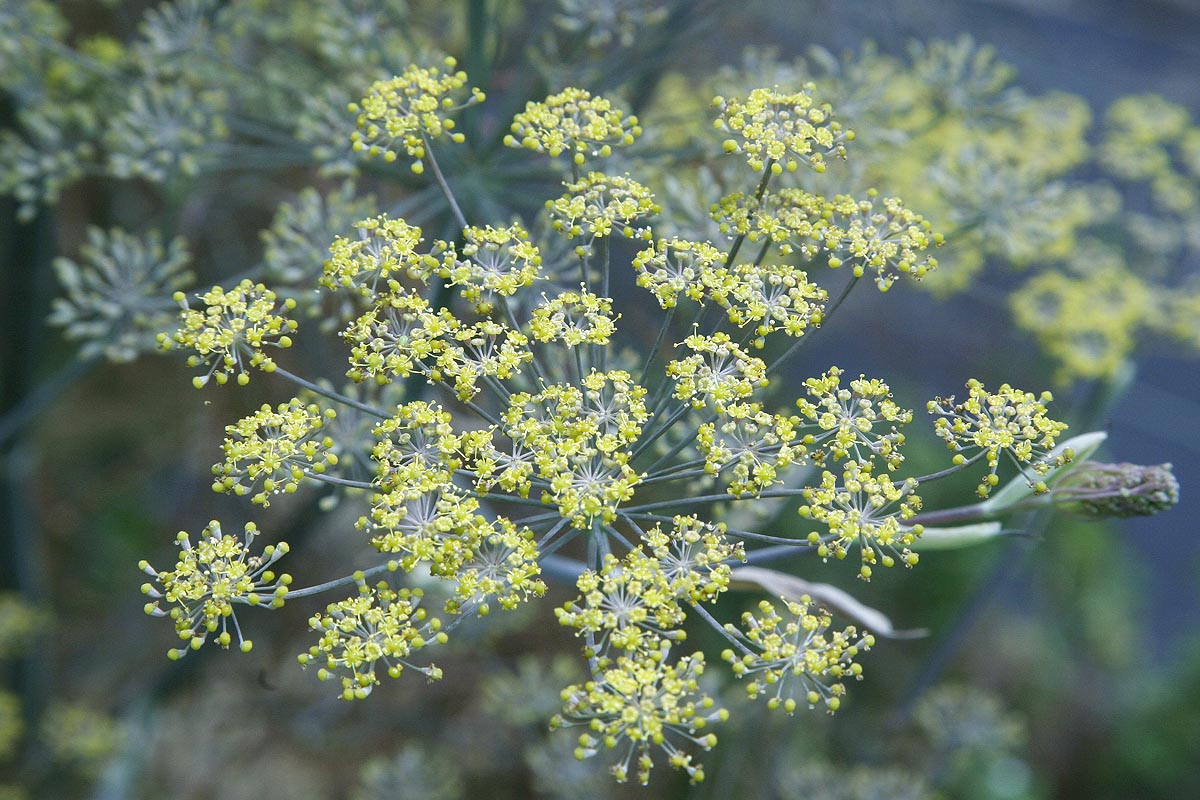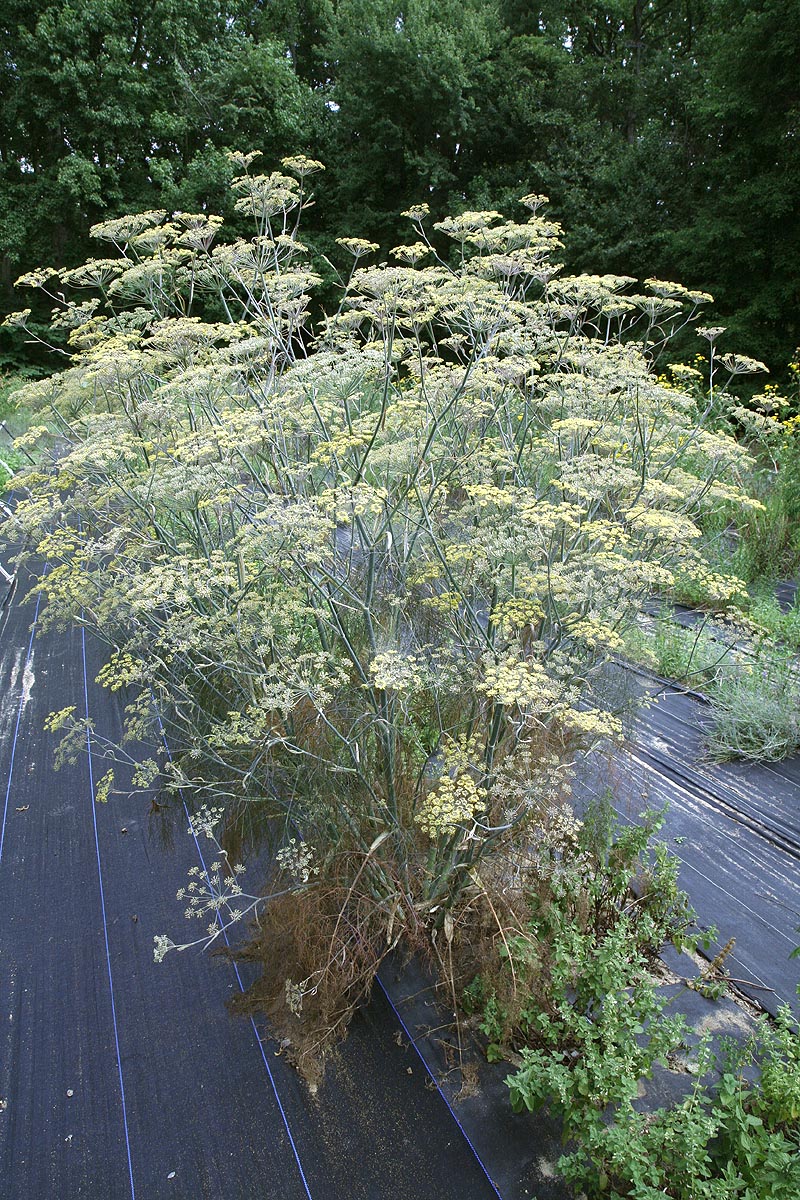Mounds of glorious light lacy fern like leaves in a mixture of bronze or smoky purple and green which often seem to hang like smoke. The plant is strongly scented with a sweet licorice flavor and scent will waft over the entire garden. At our farm the scent is noticeable a whole field away! It makes a wonderful plant all on it's own or an interesting backdrop as the bi colored fern like foliage makes an excellent contrasting backdrop for many smaller plants.. It's delicate lacy foliage adds a sense of light and air to any bed. In summer it produces tall stems up to 6 feet (2m) bearing tiny sulphur yellow flowers that are very important for pollinator insects as well as feed predatory insects which keep down other less desirable bugs in your garden. Planting several in the vegetable garden helps repel pests. The foliage is also a very important food source for the Eastern Black Swallowtail butterfly. So plant quite a few an allow the caterpillars to munch on them too and help save this beautiful butterfly. Fennel is of course well known as a digestive aid and is ideal after heavy meals causing indigestion and heartburn. Its used in many OTC medications as well as herbal formulas and is a must herb for any garden. Leaves and seeds can be dried for instant use when indigestion strikes. Deer do not eat this plant! Neither do rabbits.
Growing Bronze And Green Fennel (Foeniculum vulgare) from Seed.
Easy to grow from seed. Can either be started indoors in mid to late winter or outdoors once danger of frost has passed. Fennel produces a strong tap root that does not like to be disturbed.
Indoors. Start seeds in small pots 2-3 seeds per pot. using peat or other biodegradable pots is ideal. Lightly cover and place in good light or under grow lights. Once seeds germinate either keep as a small group or remove the weak seedlings leaving only the strong one. For more information on starting seeds see our general growing instructions.
Transplanting. Tap root forms early on fennel and does not like to be disturbed. Thus using the biodegradable pots they can just be dropped into holes in the ground without issue. If using plastic pots check them regularly and as soon as roots appear at the bottom of the pot OR the plant has reached about three inches in height, it can be transplanted. Ensure plants are hardened off before transplanting or shade plants after transplant. Dig a hole slightly larger than the pot then carefully loosen soil in pot and transfer the whole plant with soil into the hole without disturbing the roots. Water in well.
Direct sowing. Can be done as soon as frost has departed. Choose location carefully as plants cannot be moved once they are established. Prepare soil and remove weeds place 2-3 seeds in each spot about 18" (46cm) apart. Seeds can either be left as groups or weaker seedlings removed as plants grow.
Ensure it has good water as it is establishing but once its taken hold its fairly drought tolerant. However will get many more leaves and seeds if some water is given throughout the growing season. Takes little care once established just some weeding around the base of the plants.
We recommend growing a large group of fennel plants because the Eastern Black Swallowtail butterflies like to lay their eggs here, its a preferred plant. Small seedlings may need to be protected to ensure they are not eaten to death by the caterpillars but once plants are established they can endure caterpillar browsing and helping to keep a such a beautiful species alive is with a few fennel leaves. So grow some for you and some for them.
Fennel does not transplant well once its established the tap root goes deep and does not like being moved. Unless a huge chunk of soil around the plant is moved with it to ensure roots are not disturbed most mature fennel plants die on transplant. Small seedlings can be transplanted carefully from pots to their final location if roots are not disturbed.
Overwintering. Zones 7b and warmer just leave plants until spring.
Zones 6b-7a may want to use just a small amount of mulch over the plant crowns to help keep plants warm if their is a strong cold snap. For 6a and colder a much heavier mulch is recommended. Above zone 5 fennel is best grown as an annual or in large pots that can be moved inside a attached garage during the winter months to avoid freezing to hard.
We suggest not cutting stems in fall as many beneficial insects like to overwinter in the hollow stems and others lay their egg cases on them ready for spring hatching. Stems can also offer winter interest to the garden. Remove last years stalks as leaves begin to emerge from the ground.
In zones
Deer do not eat this plant! However moles and voles will eat out the roots over the winter, so take preventative measures if these pests are in your area.
Harvesting Bronze And Green Fennel (Foeniculum vulgare)
Leaves are best harvested in the spring before the flower stalks begin to form. Seeds can be harvested green or brown and ripe. green seeds should be allowed to fatten out before harvesting the whole head. Harvest ripe seeds by mid to late fall or the seeds will drop.
Seeds are prized in sausage making and are used in Chinese and many wok created dishes. Cut seeds before they turn brown and finish ripening inside for the best flavor.










